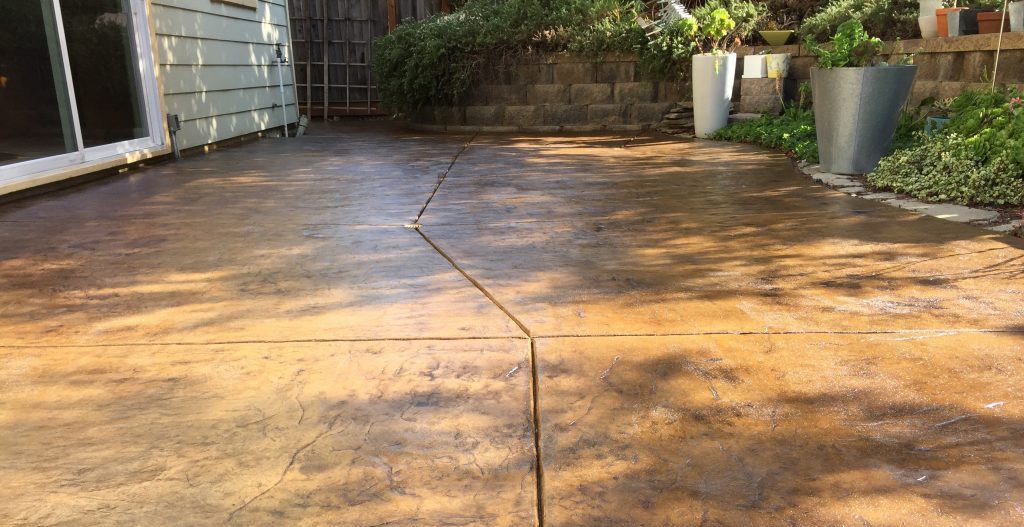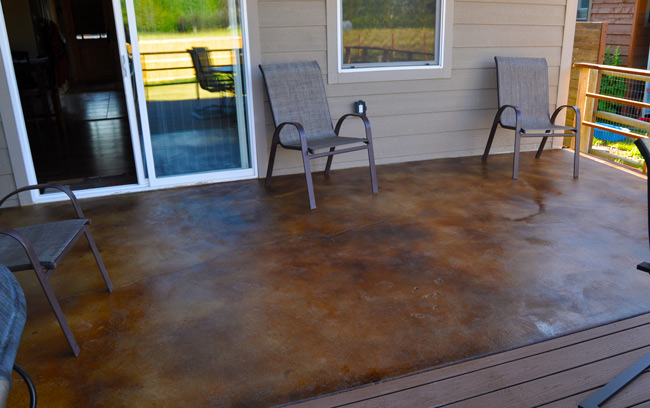Best practices for caring for stained concrete floors
Wiki Article
Recognizing the Different Kinds of Stained Concrete for Your Next Task
Stained concrete offers different choices that deal with different visual and practical needs. Each kind provides distinct characteristics that affect the final appearance and durability of the surface area. Understanding these distinctions is key for any individual intending a job. From rich, chain reactions of acid-based stains to the lively uniformity of strong color stains, the selections can substantially impact the outcome. What elements should one consider when choosing the ideal discolor for their details needs?Summary of Stained Concrete
Stained concrete acts as a flexible floor covering alternative that can enhance the aesthetic charm of various rooms. This technique includes using a coloring representative to the surface of existing concrete, allowing for a broad range of style opportunities. Stained concrete is preferred in both household and business environments, supplying a resilient and low-maintenance remedy that can imitate the look of natural products like stone or tile.The staining process can be carried out making use of water-based or solvent-based items, each supplying distinctive visual impacts. The last look is influenced by elements such as the original concrete surface area, the type of tarnish used, and the application method. Stained concrete not only enhances exterior and interiors but also advertises sustainability by renewing existing concrete frameworks. Consequently, it has acquired grip amongst property owners and developers looking for both capability and design in their flooring choices.
Acid-Based Stains: Qualities and Advantages

Distinct Shade Variants
Concrete surfaces can change dramatically with the application of acid-based stains, which provide an abundant scheme of unique color variations. These stains permeate the concrete, reacting chemically to generate dynamic planet tones that vary from deep browns and reds to soft greens and blues. The resulting hues are often variegated, creating an all-natural, marble-like look that improves the concrete's character. Each application yields distinct outcomes due to variations in the concrete's structure and the staining method utilized, making every job special. In addition, acid-based stains can be split or integrated with other methods to develop tailored layouts, enabling for individual expression. This convenience makes acid-based stains a preferred option for both domestic and commercial applications.Chemical Responses Clarified
While many variables add to the effectiveness of acid-based stains, the underlying chain reaction play an essential duty in their special qualities and benefits. These stains mainly consist of water, acid, and metallic salts. When used to concrete, the acid responds with the calcium hydroxide in the cement, creating a chemical improvement that results in irreversible color modifications. The metallic salts permeate the surface area and bond with the concrete, enabling a broad range of hues and tones. This response not only enhances visual appeal but additionally offers longevity, making the shade immune to fading and wear. Additionally, acid-based stains can produce a variegated surface that imitates natural stone, more improving their appeal for attractive concrete applications.Surface Prep Work Importance
Attaining ideal outcomes with acid-based stains depends upon thorough surface area preparation. This essential action assurances that the concrete surface is clean, without pollutants, and correctly profiled for ideal discolor absorption. Any existing sealants, dirt, or oils can impede the chain reaction that produces the preferred color and coating, resulting in irregular or patchy results.Before using the tarnish, the concrete ought to be mechanically cleansed or pressure cleaned, followed by a comprehensive examination for cracks or blemishes that may call for repair service. Additionally, confirming the surface is appropriately dried will certainly improve tarnish adherence. By prioritizing these preparatory procedures, the long life and vibrancy of acid-based stains can be significantly enhanced, causing a much more visually pleasing and durable coating.
Water-Based Stains: Attributes and Benefits

Water-based stains pass through the concrete, providing an extra transparent coating that highlights the natural texture and variations of the surface area underneath. They are offered in a wide range of shades, permitting imaginative flexibility in design. In addition, water-based stains are easier to clean up, requiring only water and soap, which simplifies the application procedure.
Their fast drying time enhances effectiveness, making them a practical option for both DIY fanatics and specialists. In general, water-based stains offer an attractive mix of visual flexibility and straightforward residential properties, making them a preferred option for concrete enhancement projects.
Solid Color Stains: Vibrant Options for a Bold Look
Strong shade stains use an efficient option for those looking for to create a bold and vibrant aesthetic on concrete surface areas. These stains give a consistent pigmentation that can significantly boost the visual charm of floors, outdoor patios, and driveways. Available in a broad spectrum of tones, solid color stains enable creative expression, providing to different design preferences.Among the essential advantages of strong color stains is their ability to conceal imperfections, providing a fresh and sleek want to maturing concrete - stained concrete contractors. In addition, their formula commonly consists of UV-resistant residential properties, making sure durability and color retention even in rough weather
Application is straightforward, needing minimal prep work of the concrete surface. When applied, strong shade stains can be sealed for included protection and shine, further raising their aesthetic top quality. With their vibrant choices, solid shade stains are an excellent selection for those going for an impactful and natural layout.
Semi-Transparent Stains: Accomplishing Depth and Measurement
Semi-transparent stains use a special technique to enhancing concrete surfaces by giving deepness and dimension via different shade options. Recognizing the application methods is vital for achieving the wanted result, while proper upkeep practices ensure long life. This section will certainly discover these crucial aspects to make best use of the advantages of semi-transparent staining.Color Options Available
A wide array of shade alternatives exists for semi-transparent stains, allowing house owners and developers to boost the natural charm of concrete surfaces. These stains can be found in a range of colors, from earthy tones like browns and terracottas to lively shades such as blues and eco-friendlies. The semi-transparent nature of these stains allows the underlying concrete to show through, developing a distinct depth and measurement that can match various design appearances. Furthermore, integrating various shades can generate personalized tones, allowing a customized try to find each project. This flexibility makes semi-transparent stains a popular choice for both interior and exterior Learn More Here applications, as they can harmonize with surrounding components while including visual rate of interest to simple concrete.Application Strategies Clarified
To attain the preferred depth and dimension with semi-transparent stains, proper application techniques are vital. Surface prep work is important; the concrete needs to be clean and free of any kind of impurities. This commonly includes power washing and fixing any kind of fractures. Next, picking the right applicator, such as a sprayer, roller, or brush, can affect the final appearance. Sprayers enable a more also application, while rollers can help attain structure. It is essential to use the discolor in slim, even layers, enabling each layer to completely dry before including one more. Manipulating the application strategy, such as varying stress or utilizing various devices, can create one-of-a-kind impacts. Lastly, securing the stained surface boosts the vibrancy of the colors while more info here giving security.Maintenance Finest Practices
Routine upkeep is necessary for maintaining the elegance and integrity of surface areas treated with semi-transparent stains. To preserve these surface areas, regular cleansing is crucial. Making use of a pH-neutral cleaner and a soft-bristle broom will certainly assist eliminate dirt and debris without harming the tarnish. It is advisable to avoid severe chemicals, as they can degrade the stain's appearance. Furthermore, periodic resealing each to three years can shield versus wear and fading. This procedure includes cleaning up the surface area completely and using a suitable sealer developed for stained concrete. Property owners need to likewise check for any signs of staining or damages and address these concerns promptly to guarantee resilient vibrancy and resilience. Complying with these best techniques will boost the total life-span of semi-transparent stained surfaces.Impacts and Methods: Customizing Your Stained Concrete
Tailoring stained concrete involves a selection of techniques that improve both aesthetic appeals and performance. Amongst these approaches, layering various stain colors can produce depth and complexity, permitting unique visual impacts. Methods such as acid staining provide a variegated appearance, while water-based stains use a much more consistent appearance.Additionally, including attractive patterns, such as stenciling or engraving, can even more personalize the surface area, including complex designs that deal with private tastes. Texturing the concrete, whether via stamping or mop surfaces, introduces tactile elements that not only boost hold but additionally improve visual passion.
Applying sealants can enhance the shade vibrancy and offer defense versus wear. Modification techniques expand beyond plain color; they can change a standard concrete slab right into a spectacular focal factor, making it appropriate for both residential and industrial rooms. With mindful option of impacts and techniques, stained concrete can accomplish a truly tailored look.
Upkeep and Longevity of Stained Surfaces
Stained concrete surfaces are known for their durability and aesthetic allure, preserving their honesty is necessary for ensuring long life. Normal cleaning is vital; sweeping and wiping with a pH-neutral cleaner assists prevent dirt accumulation and discoloration. Additionally, using a sealer every few years can secure the surface area from moisture, chemicals, and navigate here UV damage, consequently boosting its life-span.It is also vital to address any kind of splits or chips quickly. Tiny repair work can alleviate additional deterioration, preserving the visual and structural top quality of the surface area. For exterior stained concrete, seasonal maintenance, such as eliminating snow and ice, is needed to stop surface area damages from freeze-thaw cycles.
Often Asked Concerns
Can I Discolor Existing Concrete Surfaces or Only New Ones?
The inquiry of whether existing concrete surfaces can be stained emerges often. It is certainly feasible to discolor both new and old concrete, gave the surface area is effectively prepared and devoid of pollutants for perfect attachment.For how long Does the Staining Process Commonly Take?
The staining procedure generally takes one to 3 days, depending upon factors such as surface area preparation, sort of discolor, and climate condition. stained concrete floors. Healing time may expand beyond first application, affecting the overall duration substantiallyIs Stained Concrete Safe for Outdoor Use?
Stained concrete is typically secure for outdoor use, gave it is appropriately sealed. This sealing shields versus dampness and UV damage, making sure resilience and security, while additionally enhancing the visual allure of outdoor areas.Can I Use Multiple Spot Layers for Various Effects?
Using multiple discolor layers can attain diverse effects on stained concrete. It is vital to guarantee compatibility in between stains and enable proper drying out time between applications to stay clear of unintentional reactions or discoloration.Are There Any Type Of Color Limitations for Stained Concrete?
Color restrictions for stained concrete mostly rely on the sort of tarnish made use of, with water-based stains offering a broader palette compared to acid-based stains. stained concrete floors. Attaining lively shades may require mindful option and application methods.Report this wiki page